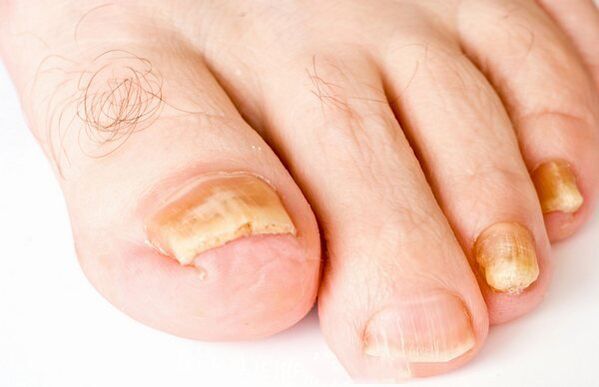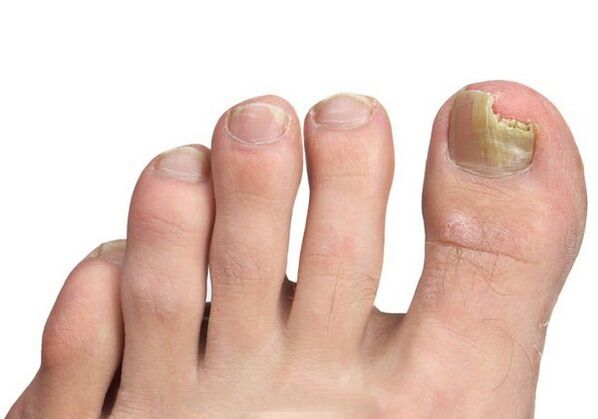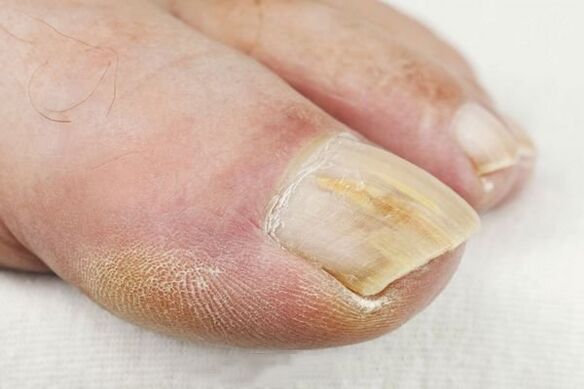Hello, dear readers.Onicycosis is a medical name for a very common disease, better known to us as a nail fungus.Recently, a leap at the level of incidence of this ailment has been observed.This unpleasant fact is associated with the popularity of cheap shoes, which is not particularly of quality.It is made of low -grade materials that have low air performance, which prevents normal foot ventilation.Under such conditions, with the sweating of the feet, ideal conditions for the productive activity of the pathogenic microflora are created.This problem is generalized.Its scope is so great that the number of cases exceeds 20% of all the inhabitants of the planet!
As the name implies, the fungus of the nail is a mythical (fungal) damage on the nail plate.There are many varieties of pathogenic fungi that can cause this disease.
But, according to doctors, in most cases, leg plates are affected by dermatophytes.Significantly less often, the cause of the development of the disease is yeast (candidiasis) and mold fungi.
Sometimes, in practice, you have to deal with the deformation of the nails on the legs of a black nature.
Symptoms of nail fungus: the first signs
Fungal damage can affect not only nails, but also feet itself.The symptoms in the infection will differ according to the variety of the pathogen that caused the development of the disease.The degree of damage to the nail plate also has a value.
But, despite the existing differences, the general signs of fungal activity can be distinguished:
- Change the color of the nail.
- The appearance of spots on the nail plate, stripes, thickness, influxes.
- Loosen the structure of the nails or their stratification.
- Redness, peeled, cracking of the skin of the feet.
- The appearance of itching, pain (even when walking), burning in the damage area.
- Inflammation, dryness of the affected areas of the skin.
- Often the feet exudate a repulsive aroma.
You can see a whitish plate at the bottom of the feet.The peeling of the skin is replaced by the appearance of small flakes of dead skin, which cover its surface.
Types of fungal lesions
Normotrophic form of damage.White or yellowish spots or strips appear on the nails.As the disease progresses, they spread, completely changing the color of the entire plate.
The thickness, as well as the brightness of its surface, remains unchanged.There may be a violation of the fusion of the nail with underwater fabrics, so it is exfolia and can be eliminated easily and without pain.

Hypertrophic form of the disease.The affected nail becomes brownish or gray yellow.A thickening of the nail plate is observed due to the growth of the submarine epithelium.The nail plate itself becomes a crumb.
The lateral parts are especially destroyed, because of this, it acquires a shade form.This is a characteristic sign of this disease.The nail surface becomes opaque.When walking, a sick person experiences pain.
Atrophic form of damage. The nail plate changes color, becoming brown gray, loses its transparency and brightness.The nail begins to collapse gradually, starting from the outside in the direction of the nail growth zone.
Growth epithelial particles fill the bed of the nail with loose dough.Without treatment, a complete nail loss will occur.
Pathogen classification of the disease
Dermatophytic lesionOccurs in the vast majority of cases (around 90%).There are several varieties.With some, the infection can be applied to the intercaps on the foot, to the skin of the legs and even to the hands.
Yeast defeat.This variety can be difficult to identify, especially in the initial stage.The nail roller is first affected, it inflates and swells.Later, peeling in this area is remarkable, light itching and weak pain can be possible.The nail becomes tuberous, loses its brightness, can crumble.In advanced cases, the purulent discharge appears.
Planning defeat.Under the influence of the mold, the nail changes, acquiring a greenish and bluish dye, or begins to blackened.
Its side parts become rough.Over time, the affected areas die, so the nail is deformed.Little by little, he will collapse.
Planning defeat is quite rare, mainly as a complication in a different form of fungal lesions, as well as HIV infection.
Classification by the location of the lesion
Fungal damage can be located in different parts of the nail.In this sense, several types of damage are distinguished in the international classification.
- Total when the fungus effect covers the entire nail.
- Distant, if only the upper part of the nail (free edge) is injured.
- Proximal, in which there is damage to the nail roller (lower part of the nail plate).
- Side, observed in the lateral parts of the nails.
They often characterize different stages of the disease.
The feet fungus injury
There are several varieties of fungal damage to the foot.
Interdalz form. The most common type of foot fungus.As the name can be seen, the disease affects the interdigital gaps, then you can also change to other parts of the feet, including nails.
In interdigital folds, wet cracks and specific leather layers appear.Later, skin erosion is remarkable.The disease has a tendency to become chronic.Often complicated by streptococcal infection
Hyperkeratic form (squamous).Touches all your foot.It differs in a fairly deep defeat from the tissues.At the beginning, the skin takes off and blushed slightly, then becomes rough and anxious, in the heels there is sometimes a deep crack of the keratinized layer.
The disease can be extended to the nails, which at the same time thickens, darken and begin to paint.The disease is very characteristic of athletes.
Dishidrotic (vesicular) form. The vesicula (bubbles with liquid) appears on the feet, which, after breaking, leaves the traces of erosion.The skin is ulcerta, with peeled areas, covered with purulent scabs.It is often accompanied by an allergic eruption (due to the action of toxins).
The disease is uncommon and is quite easily treated.But here the danger lies in the high probability of bacteria or virus lesions, which significantly complicates the course of the disease and actually excludes the possibility of rapid recovery.
Deleted form.It is not easy to identify, since changes in the skin and nail condition are weak.Nail plates can become yellowish.The sole skin is slightly peeled, it is released.You can see itchy.The disease is well provided to cure.
Nail fungus: the causes of appearance
Symptoms of the fungus of the nails and the first signs that indicate the general level of immune resistance of the body and the inappropriate care of the feet.

If the protective functions are normal, even when infected, the disease cannot be developed.Immune mechanisms will deal with the aggressor on their own.
But when immunity weakens together with the favorable related causes the development of the disease, the body cannot resist the fungus.
For an effective struggle with him, he must try to eliminate or at least minimize (for example, it is unlikely that chronic diseases are overcome completely) the influence of these factors.
The reasons for the development of the fungus:
- Excessive legs of the legs.
- Violation of the natural ventilation of the feet (dense shoes made of low quality material, synthetic socks).
- Reduction of body protection functions.
- Violation of the skin protective layer (excess hygiene, excessive treatment with antibacterial agents, fluid abuse to relieve varnish).
- Injury to the nail plate and damage to the sole of the legs (cracks, calluses, etc.).
- Features of the foot that worsen its aeration (due to flat feet, obesity, etc.).
- Concomitant diseases (diabetes, varicose veins, psoriasis, metabolic disorders, digestion, blood circulation in the legs, HIV).
- Antibiotics and some other drugs taken by a long course.
- Low foot hygiene level.
- Age and sexual criteria (men and older people are more susceptible to the disease).
- A professional factor (conditions with high temperature and humidity, dust, ionizing radiation, with rubber shoes; masseuses, orthopedists, sanatorium workers, vapors, etc.) also often get sick.
- A visit to Public Saunas, bathrooms, swimming pools.
- Pedicura of the Hall in violation of the principles of hygiene and sterility.
- Domestic factor (general use of wipes, shoes, mat in the bathroom, etc.).
As studies have demonstrated, people suffering from diabetes are more affected by the fungus of the foot and nails.This disease is observed in 35% of diabetics.
The probability of obtaining fungal damage to psoriasis is also high.Here the probability of increasing by 55%.
The consequences of fungal lesions

Although the fungus of the foot does not represent a direct threat to the patient's life, it cannot be related to their health irresponsibly and let everything be alone.
Fungal damage is not at all an annoying discomfort and an exceptionally aesthetic problem.
The timely inconsistency of the disease leads to the development of a chronic form of ailment with regular exacerbations.
They are also possible surprising complications.
- Violation of the nail growth process, which grows in soft tissues.
- Complete or partial loss of nails.
- Stagnant phenomena, including lymphostasis.
- Distribution of the disease to neighboring areas and deeply in tissues.
- Connecting other infections (bacteria, viral and fungi).
- High inflammation is an acute inflammatory infectious disease.
- Diabetic foot in diabetics are anatomical changes, which leads to an increase in the probability of injuries, infections, suppuration and necrosis (necrosis) of tissues.
- Elephantiasis is a pathological growth of the skin and subcutaneous tissues, which leads to an increase in organ size.
- Eczema.
Nail fungus treatment: economic and effective drugs
To prescribe the correct treatment regime, you must make a precise diagnosis.For this purpose, several laboratory tests are performed.Modern pharmacology offers many different antimicotic medications.
That is why independent treatment is difficult and often ineffective.The doctor will have to find out the pathogen, the degree of negligence of the disease, the damage area, the presence of concomitant diseases.
Only according to the information complex received, you can prescribe a therapy course.Here, both local medications are used (for external applications: ointments, creams, varnishes, foams, sera) and general, taken inside (tablets, capsules).
The active substance in antifungal ointments can be cyclopyrox, napticin, nystatin.
If fungus injuries are quite extensive, the use of tablet antimicotic medications is recommended.
Unlike external funds, tablets have a general effect throughout the patient's body.
Recipe medications purely based on substances of terbinafina, fluconazole, itraconazole.There is often the need to eliminate surgical formations, but there are economic and effective medications of the fungus of the nails.

Many of these funds are also indicated for preventive use.
It should be remembered that all antimicotic medications have a different side effect.Therefore, the treatment, prescription and cancellation of medicines, control of the patient's condition: all this is exclusively in the doctor's competence.
Often, the recovery process can be very prolonged, up to one year, until the affected nail is completely updated.
During the treatment period, special attention should be paid to leg hygiene.With the damage of fungal nails, the use of decorative varnishes is not allowed.
To prevent household infection, you cannot walk barefoot at home, you only allow you to wear closed shoes.You need to be treated twice a day with antimicotic agents.After using the bathroom, your careful processing is carried out.
The joint washing of things is prohibited.After the cure, you must get rid of all the objects that have contacted the feet (wipes, shoes, all socks, etc.).
Recommendations
- The legs should be kept clean and dry.Wash the feet once a day, if necessary, more frequently.After that, its surface, including interdigital gaps, dried diligently.Now you need to use only fresh socks.
- The shoes must be comfortable, not too old (no more than 3 years), from a breathable material.Poor or fashionable rubber models cannot be used daily.At least, the duration of its use during the day should be limited.For this purpose, it is recommended to use a replaceable pair.It is extremely advisable to wear other people's shoes, including shoes.
- Socks are used from cotton, wool or other non -intensive materials.It is allowed to use synthetic only in some cases.
- The most difficult thing is to destroy the fungus on wood surfaces.This should be taken into account when they visit vaporizers, bathrooms and public pools.It is better to be in a closed rubber shoe.
- Socks, room shoes, templates must be organized regularly.
- The procedure for the pedicure of the room must be carried out by a tested teacher subject to sterility rules.Or at home adhere to the same principles.It is necessary to avoid all types of nail plates lesions in all possible ways, timely eliminate the characteristic problems of the surface of the single (insensitive forms, calluses, cracks), do not abuse pedicure, degreaser and disinfectants.
Take care, follow your health.Be healthy!
















